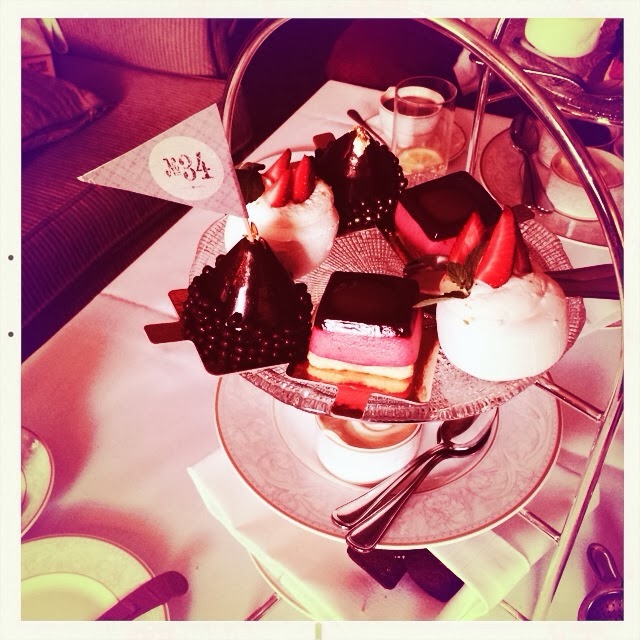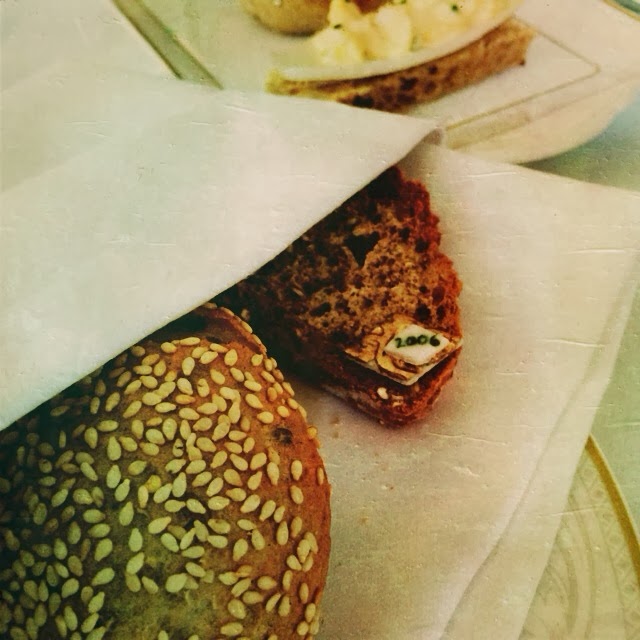 |
| 'for coal fires roared, and punch and tea were steaming' The Shelbourne - Elizabeth Bowen |
The Shelbourne Hotel, St Stephen's Green, Dublin - Monday 17th February 2014
____________________
Tea Takers
Sarah Ryan
Paul Ryan
Olivia Ryan
____________________
A half-term trip to Dublin, with another birthday to celebrate (how did my baby get to be eleven?) - inevitably there would need to be a tea, and there was a very clear choice for its location.
The Shelbourne is not only one of Dublin's oldest and smartest hotels and historically interesting, but was also the subject of a history by Elizabeth Bowen (the novelist and short story writer who has long been a particular favourite of mine, and pet research topic when a student). I dragged Lucy, then Manson, here on a pilgrimage when we were in Dublin on a choir tour in 1994, but was delighted to have the opportunity to come back and to sample the tea experience here as a part of the odyssey. I would almost like to claim EB as an honorary tea taker as she has felt part of my life for such a long time, but even I must accept some limits of reality.
It certainly lived up to our expectations and was a very delightful afternoon.
______________________
Irish literature became very much 'my thing' when I was at university and so visiting Dublin is very exciting, and the days we were there were filled with those 'I am standing on the spot where.....' thrills. The Shelbourne was a particularly fine place for indulging in this type of literary historical self-indulgence. Not only is there Bowen's charming, if rather fanciful and anecdotal, 'biography' of the place, but this was where Thackeray stayed when he visited the city, and Yeats held court here reading his poems aloud to his friends.
The hotel itself has been at the heart of many events in the history of the city and the country. Hosting the great and the good, facing the dramas of an often turbulent history, it was practically under siege during the civil war, and still bears bullet scars. The first hotel on the site was begun in three Georgian terraced houses in 1824, and then the current building built in 1866, and is an institution for which people feel great pride.
____________________
We took tea in the Lord Mayor's Lounge - a very pleasing drawing room, with long bay windows looking out over St Stephen's Green.
Elegant but also comfortable, with armchairs and sofas around low tables, it was a most pleasing setting. We even had the joy of the table next to the fire.
It was good to see that they also maintain certain key standards:
The piano music was not live, but this can be very much excused by the civilised repertoire chosen for the piped delights - a tea accompanied by such as the Goldberg variations is a tea much enhanced.
The meal itself was very impressive. It was all beautiful presented with understated elegance, and carefully served.
The sandwiches were beautifully prepared, and Paul enjoyed them very much. They were a little fussy for Olivia's and my taste (which is entirely our own problem), so we asked for some bread and butter and were delighted by the selection of warm rolls and beautiful soda bread that was swiftly provided - an extremely promising start.
An interesting addition to the tea table was the warming stand for the tea pot - a simple silver dish with a tea light inside - this is much to be recommended.
The arrival of the cakes was both an aesthetic pleasure and a generous replenishing of comestibles. The scones warmed and wrapped in a napkin were accompanied by delicious little ginger loaves. Cream and jam were plentiful. The jam was raspberry, which I know does not always meet with the approval of cream tea purists, but was very lovely all the same.
The cakes were especially to be commended and were a very interesting historical element of the tea. The menu explained it all quite fully - the chef had based these individual sweets on recipes for desserts that have been served at different times in the hotel's history:
A pavlova first served over the Horseshow weekend in August 1954;
chocolate mousse with mango and passionfruit served on the occasion on an Ireland versus Wales rugby match in 1956;
and a blackberry mousse, with caramelised apple, from the 1924 Christmas menu.
They were all delightful, but for me the blackberry mousse was quite exceptional and I was very glad that Olivia didn't want hers.
The service was excellent - friendly and efficient, but unobtrusive. Other establishments could learn a great deal from The Shelbourne.
Also, they were very lovely to the birthday girl, which is always appreciated.
This is a very high ranking tea in all aspects of the experience. Perhaps the only place it slightly lapsed was with the scones - these were perfectly nice (good middle ranking) but not quite the exceptional standards of others that we have sampled. However, everything else more than compensated for this and the quality of the food should make certain London establishments look to their laurels.
___________________
Thirty Fourth Tea - Thirty Fourth Year
_____________________
The hotel is exceedingly elegant from the iconic nubian princess and slave-girl lamp holders along its facade, to its old fashioned barbershop, via the more traditional 'smart hotel' stylings of its hallways and staircases.
The small museum displays letters from illustrious and infamous guests and houses the hotel registers which are available for browsing. I wish I had had time to pore over them to find Elizabeth Bowen's signature but it might have been a rather lengthy task.
____________________
Paying Homage
Our hotel was also on St Stephen's Green, and whilst not on the scale of The Shelbourne, was a pleasing group of three Georgian terraced houses which had been part of Newman's Catholic University buildings, and were very typically Dublin buildings. Whilst we were on the third floor, and there were many, many stairs, we did have room at the front with views over the Green.
Only on the morning we were leaving did I make the momentous discovery that it was in one of these houses that Gerard Manly Hopkins lived during his time in Dublin, so had very little time to wallow in that literary serendipity. Given that he was terribly depressed during much of his time there, perhaps it was not to be brooded on, but then this was the place where he wrote his remarkable 'terrible sonnets' which are such extraordinary works it does still seems quite tremendous to have stayed there.
Another literary pilgrimage within Georgian Dublin was to 15 Herbert Place, Elizabeth Bowen's birthplace. It is now offices, but fortunately I made my hurried visit on a Sunday and was able to photograph it without incurring curious stares.
Added to which were the constant lines of Yeats that kept springing to mind, and not just outside the Post Office, which also brought back many memories of Sixth Form and did make it feel like Clare or Jill might appear around any corner and complete the quotation.
____________________
Another truly lovely tea.
____________________
____________________


































No comments:
Post a Comment